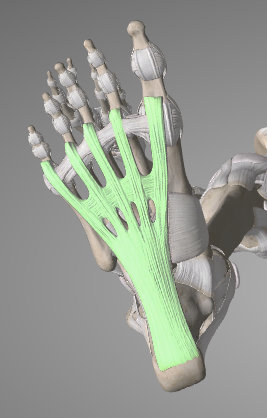by Rachel Varga
 Plantar Fasciitis is an injury to the plantar fascia, which is a thick band of connective tissue at the bottom of the foot, running from the heel to the base of each toe. It functions to support the arches of the foot, especially in weight-bearing positions and during movement.
Plantar Fasciitis is an injury to the plantar fascia, which is a thick band of connective tissue at the bottom of the foot, running from the heel to the base of each toe. It functions to support the arches of the foot, especially in weight-bearing positions and during movement.
Plantar Fasciitis is the most common reason for foot pain. In fact, it affects 10% of the population at some time in their life, and it usually starts after a sudden period of increased weight-bearing such as prolonged standing, walking or running.
Some of the other predisposing factors to the development of Plantar Fasciitis can include:
- Increased arch height or flat feet
- Poor foot and ankle mobility
- Calf muscle weakness
- Tight hamstring muscles
- Improper footwear or training surface
Where you can expect to experience pain with Plantar Fasciitis is on the bottom of the heel. There are also a few hallmark signs associated with the injury. These include experiencing pain first thing in the morning after standing on your feet, increased pain after a prolonged period of sitting that improves with a little bit of movement, but then worsens again with too much movement, as well as pain walking barefoot.
There is strong evidence for physical therapy intervention in the management of Plantar Fasciitis. In particular, manual therapy and exercise focused on strength and movement training is supported.
Here are three of my favourite exercises for treating Plantar Fasciitis:
Ankle Dorsiflexion Mobilization

Position yourself in standing with your foot on top of an elevated surface.

Keeping your heel on the surface, perform a gentle lunge to bring your knee over your toes. Hold this position for 5 seconds and repeat 10-15 times.
1st Toe Extension Mobilization

Position yourself in standing and place a lacrosse ball underneath your big toe.

Keeping your heel on the ground, perform a gentle lunge over the lacrosse ball. Hold this position for 5 seconds and repeat 10-15 times.
2 Up/1 Down Calf Raise

Position yourself on an elevated surface with your heels hanging off. Go up onto the toes of both your feet (at a 1-2 second count).

Then lift your non-affected foot to slowly lower down on your affected foot only (at a 5-6 second count). Perform 3 sets of 10 repetitions.
Although Plantar Fasciitis can persist for a very long time, sometimes months-to-years, it has been shown that a large proportion of patients (80-90%) can recover in 6-12 months of conservative management. So, if you are someone who thinks they might be dealing with a new or old injury to the plantar fascia and would like to learn how to best manage the issue, book an appointment with our Registered Physiotherapist, Rachel Varga, at Synergy Sports Medicine East on the Danforth!

Rachel Varga
Physiotherapist - B.A. Hons (Kin), MSc.PT
Rachel Varga is a physiotherapist practicing at Synergy Sports Medicine, East End (2017 Danforth Avenue)


